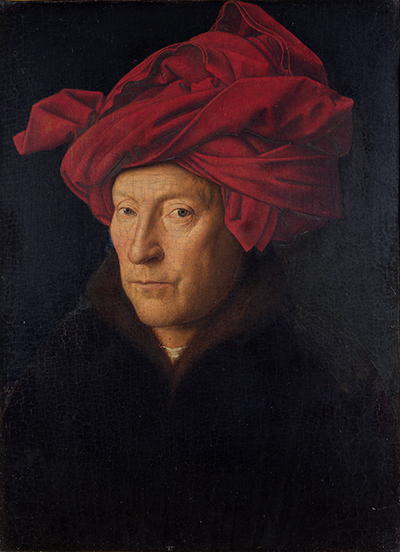Learn more about the man behind the paintings with this list of attributed quotes by, and about, Jan van Eyck
Quotes by Jan van Eyck
Very few Renaissance artists have many attributed quotes from their lifetimes, predominantly due to the shear numbers of years that have passed since then.
In the days before software, documentation would only have one single hard copy that could easily be damaged at some point over the past few centuries, slowly narrowing the documentation that we have available on artists of that period.
Jan van Eyck considered the frames that presented his paintings to be of a far greater significance than by other previous artists. He would paint them and inscribe various signatures of messages. These proved one of the best sources of information and discussion on his personality, though sadly some frames were painted over by other artists later on.
I do as I can
The inscription on the frame of Man in the Red Turban
Tangible piece of luminous matter, they confront us with a reconstruction rather than a mere representation of the visible world.
United with its frame.
Famous Quotes about Jan van Eyck
The extraordinary thing about Van Eyck is how he comes out of nowhere, and has somehow worked out how to translate into paint the different kinds of sheen on brocade cloth, glass, wood, different kinds of metal, stone, glass, wax, flesh, and all sorts of diverse shine and reflections, all absolutely perfectly... It isn't possible to paint like that from imagination. So his workshop must have been close to a Hollywood movie: costumes, lighting, camera, let’s go!
Rembrandt put more in the face than anyone else ever has, before or since, because he saw more. And that was not a matter of using a camera. That was to do with his heart. The Chinese say you need three things for paintings: the hand, the eye and the heart. I think that remark is very, very good. Two won’t do. A good eye and heart is not enough, neither is a good hand and eye.
David Hockney
Van Eyck was highly sought after as a portrait artist. Growing affluence across northern Europe meant that portraiture was no longer the preserve of royalty or the high aristocracy. An emerging merchant middle class, coupled with a growing awareness of humanist ideas of individual identity, led to a demand for portraits.
Van Eyck's portraits are characterized by his manipulation of oil paint and meticulous attention to detail; his keen powers of observation and his tendency to apply layers of thin translucent glazes to create intensity of color and tone. He pioneered portraiture during the 1430s and was admired as far away as Italy for the naturalness of his depictions.
Wikipedia
Van Eyck appears to have painted many religious commissions and portraits of Burgundian courtiers, local nobles, churchmen and merchants. A small group of his paintings survive with dates from 1432 onwards. One of his most famous works is the 'Arnolfini Portrait', signed and dated 1434. It is thought that his 'Portrait of a Man' may be a self portrait.
The National Gallery, London, UK
Jan van Eyck is the most famous member of a family of painters traditionally believed to have originated from the town of Maaseik, in the diocese of Liège. The work of the Van Eycks, epitomized in the Ghent Altarpiece, brought an unprecedented realism to the themes and figures of late medieval art.
The Metropolitan Museum of Art, New York
Jan van Eyck, Netherlandish painter who perfected the newly developed technique of oil painting. His naturalistic panel paintings, mostly portraits and religious subjects, made extensive use of disguised religious symbols. His masterpiece is the altarpiece in the cathedral at Ghent, The Adoration of the Mystic Lamb (also called the Ghent Altarpiece, 1432). Hubert van Eyck is thought by some to have been Jan’s brother.
Encyclopædia Britannica




